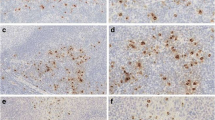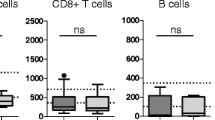Abstract
Mature natural killer (NK)-cell neoplasms include extranodal NK/T cell lymphoma, nasal type (ENKL), aggressive NK-cell leukemia (ANKL) and chronic lymphoproliferative disorders of NK cells (CLPD-NK). Granulysin, a cytolytic granule protein, is expressed in cytotoxic T cells and NK cells, and is found in the sera as well, and functions as a cytotoxic and proinflammatory protein. Cytolytic proteins, such as granzyme B and perforin, have been shown to play crucial pathophysiological roles in NK/T cell neoplasms and have also been utilized for diagnostic purposes. Granulysin in NK-cell proliferative disorders, however, has yet to be fully analyzed. To elucidate the clinical relevance of granulysin in mature NK-cell neoplasms, we measured serum granulysin and analyzed cytolytic molecules immunohistologically. The median concentrations of serum granulysin were 39.0, 2.85, 2.8 and 1.35 ng/ml in ANKL, ENKL, CLPD-NK and healthy subjects, respectively (P < 0.01). Serum granulysin was significantly elevated in patients with ANKL compared with the levels in ENKL (P = 0.006) and CLPD-NK (P = 0.037). Furthermore, serum granulysin was correlated with whole-blood EBV viral load in ENKL and ANKL (P = 0.005) and was significantly reduced after treatment. Different expression patterns of cytolytic granule proteins were observed among the mature NK-cell neoplasms. Granulysin is closely associated with the characteristics of NK-cell neoplasms and serum granulysin may serve as a novel biomarker for these disorders.





Similar content being viewed by others
References
Suzuki R. Leukemia and lymphoma of natural killer cells. J Clin Exp Hematopathol. 2005;45:20.
Ishida F, Kwong YL. Diagnosis and management of natural killer-cell malignancies. Expert Rev Hematol. 2010;3:593–602.
Rabbani GR, Phyliky RL, Tefferi A. A long-term study of patients with chronic natural killer cell lymphocytosis. Br J Haematol. 1999;106:960–6.
Tefferi A, Li CY, Witzig TE, Dhodapkar MV, Okuno SH, Phyliky RL. Chronic natural killer cell lymphocytosis: a descriptive clinical study. Blood. 1994;84:2721–5.
Asano N, Suzuki R, Kagami Y, Ishida F, Kitamura K, Fukutani H, Morishima Y, Takeuchi K, Nakamura S. Clinicopathologic and prognostic significance of cytotoxic molecule expression in nodal peripheral T-cell lymphoma, unspecified. Am J Surg Pathol. 2005;29:1284–93.
Wu X, Li P, Zhao J, Yang X, Wang F, Yang YQ, Fang F, Xu Y, Zhang H, Wang WY, Yi C. A clinical study of 115 patients with extranodal natural killer/T-cell lymphoma, nasal type. Clin Oncol (R Coll Radiol). 2008;20:619–25.
Schwartz EJ, Molina-Kirsch H, Zhao S, Marinelli RJ, Warnke RA, Natkunam Y. Immunohistochemical characterization of nasal-type extranodal NK/T-cell lymphoma using a tissue microarray: an analysis of 84 cases. Am J Clin Pathol. 2008;130:343–51.
Ko YH, Ree HJ, Kim WS, Choi WH, Moon WS, Kim SW. Clinicopathologic and genotypic study of extranodal nasal-type natural killer/T-cell lymphoma and natural killer precursor lymphoma among Koreans. Cancer. 2000;89:2106–16.
Takahashi E, Asano N, Li C, Tanaka T, Shimada K, Shimada S, Yoshino T, Kojima M, Hara K, Eimoto T, Nakamura S. Nodal T/NK-cell lymphoma of nasal type: a clinicopathological study of six cases. Histopathology. 2008;52:585–96.
Takeshita M, Yamamoto M, Kikuchi M, Kimura N, Nakayama J, Uike N, Daimaru H, Sawada H, Okamura T. Angiodestruction and tissue necrosis of skin-involving CD56 + NK/T-cell lymphoma are influenced by expression of cell adhesion molecules and cytotoxic granule and apoptosis-related proteins. Am J Clin Pathol. 2000;113:201–11.
Krensky AM, Clayberger C. Biology and clinical relevance of granulysin. Tissue Antigens. 2009;73:193–8.
Chung WH, Hung SI, Yang JY, Su SC, Huang SP, Wei CY, Chin SW, Chiou CC, Chu SC, Ho HC, Yang CH, Lu CF, Wu JY, Liao YD, Chen YT. Granulysin is a key mediator for disseminated keratinocyte death in Stevens–Johnson syndrome and toxic epidermal necrolysis. Nat Med. 2008;14:1343–50.
Nagasawa M, Kawamoto H, Tsuji Y, Mizutani S. Transient increase of serum granulysin in a stage IVs neuroblastoma patient during spontaneous regression: case report. Int J Hematol. 2005;82:456–7.
Saigusa S, Ichikura T, Tsujimoto H, Sugasawa H, Majima T, Kawarabayashi N, Chochi K, Ono S, Kinoshita M, Seki S, Ogawa K, Mochizuki H. Serum granulysin level as a novel prognostic marker in patients with gastric carcinoma. J Gastroenterol Hepatol. 2007;22:1322–7.
Nagasawa M, Isoda T, Itoh S, Kajiwara M, Morio T, Shimizu N, Ogawa K, Nagata K, Nakamura M, Mizutani S. Analysis of serum granulysin in patients with hematopoietic stem-cell transplantation: its usefulness as a marker of graft-versus-host reaction. Am J Hematol. 2006;81:340–8.
Sarwal MM, Jani A, Chang S, Huie P, Wang Z, Salvatierra O Jr, Clayberger C, Sibley R, Krensky AM, Pavlakis M. Granulysin expression is a marker for acute rejection and steroid resistance in human renal transplantation. Hum Immunol. 2001;62:21–31.
Nagasawa M, Ogawa K, Imashuku S, Mizutani S. Serum granulysin is elevated in patients with hemophagocytic lymphohistiocytosis. Int J Hematol. 2007;86:470–3.
Nagasawa M, Ogawa K, Nagata K, Shimizu N. Serum granulysin as a possible biomarker of natural killer cell neoplasms. Br J Haematol. 2009;148:812–4.
Chan JKC, Jaffe ES, Raffeld E, Ko YH. Aggressive NK-cell leukemia. In: Swerdlow SH, Campo E, Harris NL, Jaffe ES, Pileri SA, Stein H, et al., editors. WHO classification of tumours of haematopoietic and lymphoic tissues. Lyon: IARC; 2008. p. 276–7.
Chan JKC, Quintanilla-Martinez L, Ferry JA, Peh SC. Extranodal NK/T-cell lymphoma, nasal type. In: Swerdlow SH, Campo E, Harris NL, Jaffe ES, Pileri SA, Stein H, et al., editors. WHO classification of tumours of haematopoietic and lymphoic tissues. Lyon: IARC; 2008. p. 285–8.
Villamor N, Morice WG, Chan AC, Foucar K. Chronic lymphoproliferative disorders of NK cells. In: Swerdlow SH, Campo E, Harris NL, Jaffe ES, Pileri SA, Stein H, et al., editors. WHO classification of tumours of haematopoietic and lymphoic tissues. Lyon: IARC; 2008. p. 274–5.
Ishida F, Ko YH, Kim WS, Suzumiya J, Isobe Y, Oshimi K, Nakamura S, Suzuki R. Aggressive natural killer cell leukemia: therapeutic potential of l-asparaginase and allogeneic hematopoietic stem cell transplantation. Cancer Sci. 2012;103:1079–83.
Ogawa K, Takamori Y, Suzuki K, Nagasawa M, Takano S, Kasahara Y, Nakamura Y, Kondo S, Sugamura K, Nakamura M, Nagata K. Granulysin in human serum as a marker of cell-mediated immunity. Eur J Immunol. 2003;33:1925–33.
Ito T, Makishima H, Nakazawa H, Kobayashi H, Shimodaira S, Nakazawa Y, Kitano K, Matsuda K, Hidaka E, Ishida F. Promising approach for aggressive NK cell leukaemia with allogeneic haematopoietic cell transplantation. Eur J Haematol. 2008;81:107–11.
Makishima H, Ito T, Asano N, Nakazawa H, Shimodaira S, Kamijo Y, Nakazawa Y, Suzuki T, Kobayashi H, Kiyosawa K, Ishida F. Significance of chemokine receptor expression in aggressive NK cell leukemia. Leukemia. 2005;19:1169–74.
Makishima H, Ito T, Momose K, Nakazawa H, Shimodaira S, Kamijo Y, Nakazawa Y, Ichikawa N, Ueno M, Kobayashi H, Kitano K, Saito H, Kiyosawa K, Ishida F. Chemokine system and tissue infiltration in aggressive NK-cell leukemia. Leuk Res. 2007;31:1237–45.
Ishida F, Nishina S, Asano N, Sasaki S, Sekiguchi N, Nakazawa H, Ito T, Shikama N. Late relapse of extranodal natural killer/T cell lymphoma, nasal type, after more than ten years. Leuk Lymphoma. 2010;51:171–3.
Suzuki R, Suzumiya J, Yamaguchi M, Nakamura S, Kameoka J, Kojima H, Abe M, Kinoshita T, Yoshino T, Iwatsuki K, Kagami Y, Tsuzuki T, Kurokawa M, Ito K, Kawa K, Oshimi K. Prognostic factors for mature natural killer (NK) cell neoplasms: aggressive NK cell leukemia and extranodal NK cell lymphoma, nasal type. Ann Oncol. 2010;21:1032–40.
Gansert JL, Kiessler V, Engele M, Wittke F, Rollinghoff M, Krensky AM, Porcelli SA, Modlin RL, Stenger S. Human NKT cells express granulysin and exhibit antimycobacterial activity. J Immunol. 2003;170:3154–61.
Clayberger C, Krensky AM. Granulysin. Curr Opin Immunol. 2003;15:560–5.
Kishi A, Takamori Y, Ogawa K, Takano S, Tomita S, Tanigawa M, Niman M, Kishida T, Fujita S. Differential expression of granulysin and perforin by NK cells in cancer patients and correlation of impaired granulysin expression with progression of cancer. Cancer Immunol Immunother. 2002;50:604–14.
Yamaguchi M, Kwong YL, Kim WS, Maeda Y, Hashimoto C, Suh C, Izutsu K, Ishida F, Isobe Y, Sueoka E, Suzumiya J, Kodama T, Kimura H, Hyo R, Nakamura S, Oshimi K, Suzuki R. Phase II study of SMILE chemotherapy for newly diagnosed stage IV, relapsed, or refractory extranodal natural killer (NK)/T-cell lymphoma, nasal type: the NK-Cell Tumor Study Group study. J Clin Oncol. 2011;29:4410–6.
Yamaguchi M, Tobinai K, Oguchi M, Ishizuka N, Kobayashi Y, Isobe Y, Ishizawa K, Maseki N, Itoh K, Usui N, Wasada I, Kinoshita T, Ohshima K, Matsuno Y, Terauchi T, Nawano S, Ishikura S, Kagami Y, Hotta T, Oshimi K. Phase I/II study of concurrent chemoradiotherapy for localized nasal natural killer/T-cell lymphoma: Japan Clinical Oncology Group Study JCOG0211. J Clin Oncol. 2009;27:5594–600.
Gamen S, Hanson DA, Kaspar A, Naval J, Krensky AM, Anel A. Granulysin-induced apoptosis. I. Involvement of at least two distinct pathways. J Immunol. 1998;161:1758–64.
Tewary P, Yang D, de la Rosa G, Li Y, Finn MW, Krensky AM, Clayberger C, Oppenheim JJ. Granulysin activates antigen-presenting cells through TLR4 and acts as an immune alarmin. Blood. 2010;116:3465–74.
Nava VE, Jaffe ES. The pathology of NK-cell lymphomas and leukemias. Adv Anat Pathol. 2005;12:27–34.
Ohshima K, Suzumiya J, Shimazaki K, Kato A, Tanaka T, Kanda M, Kikuchi M. Nasal T/NK cell lymphomas commonly express perforin and Fas ligand: important mediators of tissue damage. Histopathology. 1997;31:444–50.
Li T, Zhang B, Ye Y, Yin H. Immunohistochemical and genetic analysis of Chinese nasal natural killer/T-cell lymphomas. Hum Pathol. 2006;37:54–60.
Teruya-Feldstein J, Jaffe ES, Burd PR, Kanegane H, Kingma DW, Wilson WH, Longo DL, Tosato G. The role of Mig, the monokine induced by interferon-gamma, and IP-10, the interferon-gamma-inducible protein-10, in tissue necrosis and vascular damage associated with Epstein-Barr virus-positive lymphoproliferative disease. Blood. 1997;90:4099–105.
Acknowledgments
We thank Dr. K. Kitano, Matsumoto Medical Center Matsumoto Hospital, for providing the patient information. A part of this study was presented at the 52nd American Society of Hematology Annual Meeting, 2010.
Conflict of interest
The authors declare that they have no potential conflicts of interest.
Author information
Authors and Affiliations
Corresponding author
About this article
Cite this article
Sekiguchi, N., Asano, N., Ito, T. et al. Elevated serum granulysin and its clinical relevance in mature NK-cell neoplasms. Int J Hematol 96, 461–468 (2012). https://doi.org/10.1007/s12185-012-1159-x
Received:
Revised:
Accepted:
Published:
Issue Date:
DOI: https://doi.org/10.1007/s12185-012-1159-x




